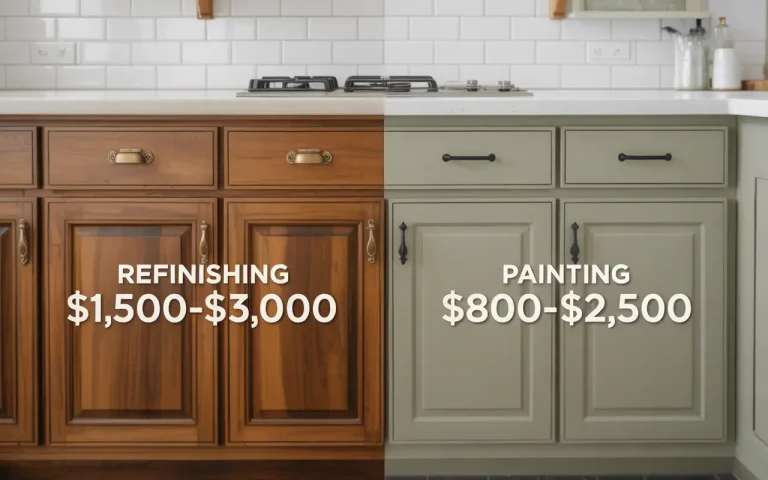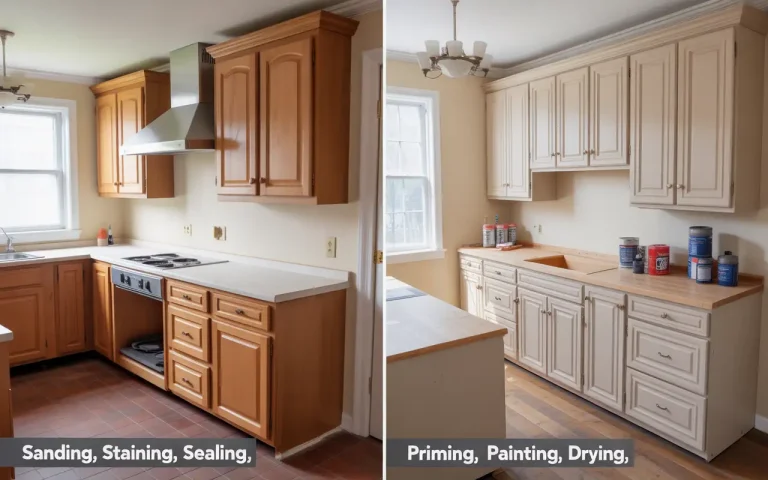Cabinet Refinishing vs Painting: ROI Comparison 2025
Staring at outdated kitchen cabinets wondering if you should grab a paintbrush or call a refinishing expert? You’re not alone in this dilemma – 67% of homeowners struggle with this exact decision. This comprehensive Cabinet Refinishing vs Painting comparison will help you make the right choice for your kitchen transformation. We’ll break down everything from $200 DIY painting to $3,000 professional refinishing to help you decide the best path forward.

Should I Paint or Refinish My Kitchen Cabinets?
The answer depends on five key factors that will determine your best option. Let’s walk through this quick assessment tool to guide your decision.
Table of Contents
ToggleFactors to Consider
Before you make a choice, look at the condition of your cabinets. Are they in good shape? Do you want to show off natural wood or cover it completely?
Refinishing kitchen cabinets works best when your cabinets are solid and have light surface wear. You get to keep the wood’s natural grain. Painting, on the other hand, hides imperfections and lets you update your space with any color.
Ask yourself:
- Are your cabinets scratched or stained?
- Do you want a modern color or a rustic wood look?
- What’s your budget?
- How long do you want the results to last?
Understanding the Investment
Let’s talk about cost.
- Refinishing costs less than replacing and often less than painting.
- Painting may cost more in labor, especially if it needs multiple coats of paint.
Think long-term. Refinishing wood cabinets may last longer and cost less over time, especially for high-quality wood. But if you want a bold change, painting may feel worth it—even if you repaint again later.
What Is Cabinet Refinishing?
Cabinet refinishing is the professional restoration of your cabinet’s original wood surface. This process brings back the natural beauty of wood while extending its life by 10-15 years.
The Complete Refinishing Process
The refinishing process starts with careful hardware removal and cataloging. Every hinge, handle, and drawer pull gets tagged for proper reinstallation. Next comes deep cleaning and degreasing to remove years of kitchen buildup.
Sanding happens in stages. Professionals start with 80-grit sandpaper to remove old finish, then progress through 120-grit and finish with 220-grit for smooth surfaces. This creates the perfect base for new stains.
Wood conditioning prepares the surface for even stain absorption. This step prevents blotchy results and ensures consistent color throughout. Stain application requires skill and patience. Multiple thin coats work better than one thick application.
The protective topcoat seals everything in. Modern polyurethane finishes provide excellent durability against daily kitchen use. Finally, all hardware gets reinstalled in its original positions.
Timeline and Tools
Most kitchen cabinet refinishing takes 5-7 days for completion. Professional crews use specialized sanders, spray equipment, and controlled drying environments. DIY refinishing requires extensive preparation and quality tools for good results.
What Are the Benefits of Cabinet Refinishing?
Aesthetic Advantages
Refinishing preserves natural wood grain and character that makes each cabinet unique. Professional-grade finishes enhance existing wood beauty with rich depth and clarity. You can choose from 50+ popular stain colors to match your style preferences.
The timeless appeal of refinished wood doesn’t date quickly like painted surfaces. Natural wood complements both traditional and modern kitchen designs without looking outdated.
Financial Benefits
Compare refinishing costs of $1,500-$3,000 against $15,000-$25,000 for cabinet replacement. That’s massive savings for similar visual impact. Refinished cabinets increase home value by 15-20% according to real estate professionals.
Long-term maintenance costs stay lower with refinished surfaces. Quality wood finishes resist daily wear better than paint. Energy efficiency improves with proper sealing of cabinet joints and surfaces.
Practical Advantages
Refinishing maintains original cabinet structural integrity. Your existing cabinet boxes, hinges, and hardware stay in place. This process extends cabinet lifespan by 10-15 years with proper care.
The environmentally sustainable option reduces waste compared to replacement. You preserve original craftsmanship while updating appearance. Quality hardwood cabinets deserve this investment in restoration.
What Is Cabinet Painting?
Cabinet painting is a professional-grade coating system designed for complete color transformation. Modern cabinet painting goes far beyond simple brush-on paint jobs.
Advanced Painting Process
Surface preparation starts with thorough cleaning protocols. Grease, grime, and residue must be completely removed before painting begins. Primer selection matters greatly – bonding primers work best on glossy surfaces while blocking primers prevent stains from bleeding through.
Sanding techniques create optimal adhesion. Light sanding with 220-grit paper roughens the surface just enough for paint to grip properly. Too much sanding damages the substrate; too little causes adhesion problems.
Professional application methods make the difference. Spray application provides smoother finishes than brush work. Multiple thin coats of paint create better coverage than single thick applications. Each coat needs proper drying time before the next layer.
Curing and hardening take time. Fresh coats of paint need 24-48 hours between applications. Full cure takes 7-14 days depending on temperature and humidity conditions.
2025 Technology Integration
Modern paint formulations include low-VOC and zero-VOC options for healthier indoor air. Advanced adhesion promoters help paint stick to difficult surfaces. Quick-cure formulations reduce project timelines. Antimicrobial coatings resist bacteria growth in kitchen environments.
Professional vs DIY Indicators
Professional cabinet painters use spray equipment and controlled environments. DIY projects rely on brushes and rollers with mixed results. Complex cabinet designs require professional expertise for quality outcomes.
What Are the Benefits of Cabinet Painting?
Aesthetic Flexibility
Painted cabinets let you completely change your kitchen’s vibe. Want sleek white? Go for it. Prefer moody navy or deep green? No problem.
You can also mix it up with two-tone cabinets or go modern with black or charcoal.
Popular 2025 colors:
- Warm neutrals
- Soft greens
- Deep blues
- Earthy tones
Painting helps you update your kitchen cabinets without tearing them out.
Faster Process and Immediate Results
Compared to refinishing, painting is often quicker. A quick cabinet makeover might only take a few days.
If you’re on a tight schedule or prepping to sell your home, painting offers fast impact.
Affordable Option for a Fresh Look
Painting your kitchen cabinets is cheaper than full refacing or replacement. It’s a smart option if:
- You’re on a budget
- You rent
- You want a temporary change
Cabinet Refinishing vs Painting: Which Should You Choose?

Cost Analysis Breakdown
Refinishing runs $15-$25 per square foot for professional work. Painting costs $8-$18 per square foot depending on complexity. Hidden costs include prep work, materials, and labor time.
Long-term value comparison favors refinishing for durability. Painting wins on upfront affordability and design flexibility.
Durability and Longevity
Refinishing lasts 15-20 years with proper maintenance. Painted cabinets typically last 8-12 years depending on usage patterns. Kitchen traffic and humidity affect both options.
Maintenance requirements differ significantly. Refinished surfaces need occasional cleaning and touch-ups. Painted cabinets may need fresh coats every 8-10 years.
Decision Matrix
Choose Refinishing If:
- You have quality solid wood cabinets
- Natural wood aesthetic is preferred
- Long-term investment mindset guides decisions
- Traditional or transitional style homes
Choose Painting If:
- Budget constraints limit options ($500-$1,500)
- Color change is desired
- Quick transformation is needed
- Modern/contemporary style preference
Cabinet refinishing is ideal for those looking to restore a worn finish, while cabinet painting offers a new, vibrant look with more color options.
Professional Expertise
San Diego Custom Painting offers both cabinet refinishing and painting services. Their expertise extends to Exterior Painting Services and Interior Painting Services in San Diego, providing comprehensive solutions for complete home transformations.
Frequently Asked Questions
Is it better to refinish cabinets or paint them?
The answer depends on cabinet material, budget, and desired outcome. Refinishing works best for solid wood cabinets when you want natural aesthetics and long-term value. Painting is ideal for budget-conscious projects, color changes, and quick updates.
How long does cabinet refinishing last?
Cabinet refinishing typically lasts 15-20 years with proper maintenance. Factors affecting longevity include kitchen usage patterns, humidity levels, maintenance frequency, and original wood quality. Regular cleaning and annual inspections maximize lifespan.
What is the difference between painting and refinishing?
Refinishing involves surface restoration while maintaining original material. Painting applies complete surface coating with new material. Process differences include sanding depth and material application methods. Outcomes vary in appearance, durability, and maintenance requirements.
What is the kitchen trend in 2025?
Trends this year focus on:
- Natural wood tones
- Two-tone cabinets
- Flat panel doors
- Matte and soft-touch finishes
Expect more warm woods, deep colors, and minimal hardware. You don’t need to replace your cabinets, just refinish or paint them to match.
What is the most popular kitchen cabinet color right now?
Current top colors include warm white (Classic White, Alabaster), sage green (trending 40% increase), navy blue (timeless elegance), natural wood tones (sustainability focus), and charcoal gray (modern sophistication). Regional variations and seasonal considerations affect color selection.
